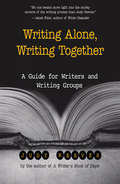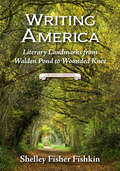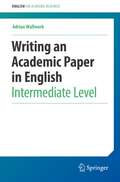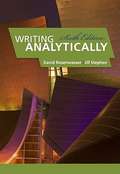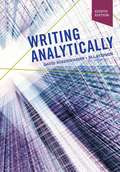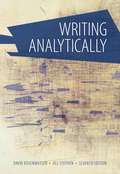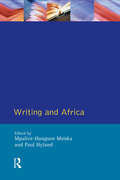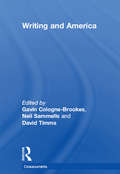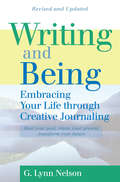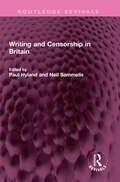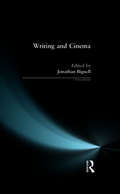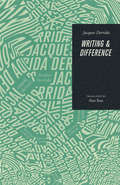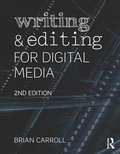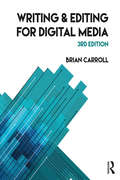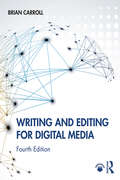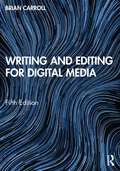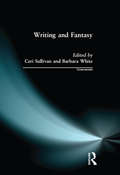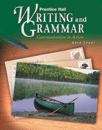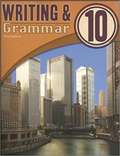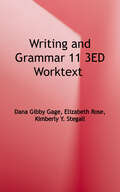- Table View
- List View
Writing Alone, Writing Together
by Judy ReevesThe lonely life of a writer need not be. There are ways to break that isolation and find encouragement and support within groups of like-minded people. Sections in Writing Alone, Writing Together include Writing Practice Groups, Creating Writing Prompts, Group Leadership, and even What to Do with the Bores, Whiners, Control Junkies, and Thugs. Whether the group is oriented toward writing the great American novel or a family memory book, this useful book offers an array of effective techniques to help writers achieve their goals.
Writing America
by Shelley Fisher FishkinAmerican novelist E.L. Doctorow once observed that literature "endows places with meaning." Yet, as this wide-ranging new book vividly illustrates, understanding the places that shaped American writers' lives and their art can provide deep insight into what makes their literature truly meaningful. Published on the eve of the 50th anniversary of the Historic Preservation Act, Writing America is a unique, passionate, and eclectic series of meditations on literature and history, covering over 150 important National Register historic sites, all pivotal to the stories that make up America, from chapels to battlefields; from plantations to immigration stations; and from theaters to internment camps. The book considers not only the traditional sites for literary tourism, such as Mark Twain's sumptuous Connecticut home and the peaceful woods surrounding Walden Pond, but also locations that highlight the diversity of American literature, from the New York tenements that spawned Abraham Cahan's fiction to the Texas pump house that irrigated the fields in which the farm workers central to Gloria Anzaldúa's poetry picked produce. Rather than just providing a cursory overview of these authors' achievements, acclaimed literary scholar and cultural historian Shelley Fisher Fishkin offers a deep and personal reflection on how key sites bore witness to the struggles of American writers and inspired their dreams. She probes the global impact of American writers' innovative art and also examines the distinctive contributions to American culture by American writers who wrote in languages other than English, including Yiddish, Chinese, and Spanish. Only a scholar with as wide-ranging interests as Shelley Fisher Fishkin would dare to bring together in one book writers as diverse as Gloria Anzaldúa, Nicholas Black Elk, David Bradley, Abraham Cahan, S. Alice Callahan, Raymond Chandler, Frank Chin, Elizabeth Cook-Lynn, Countee Cullen, Frederick Douglass, Paul Laurence Dunbar, Jessie Fauset, William Faulkner, F. Scott Fitzgerald, Allen Ginsberg, Jovita González, Rolando Hinojosa, Langston Hughes, Zora Neale Hurston, Lawson Fusao Inada, James Weldon Johnson, Erica Jong, Maxine Hong Kingston, Irena Klepfisz, Nella Larsen, Emma Lazarus, Sinclair Lewis, Genny Lim, Claude McKay, Herman Melville, N. Scott Momaday, William Northup, John Okada, Miné Okubo, Simon Ortiz, Américo Paredes, John P. Parker, Ann Petry, Tomás Rivera, Wendy Rose, Morris Rosenfeld, John Steinbeck, Harriet Beecher Stowe, Henry David Thoreau, Mark Twain, Yoshiko Uchida, Tino Villanueva, Nathanael West, Walt Whitman, Richard Wright, Hisaye Yamamoto, Anzia Yezierska, and Zitkala-Ša. Leading readers on an enticing journey across the borders of physical places and imaginative terrains, the book includes over 60 images, and extended excerpts from a variety of literary works. Each chapter ends with resources for further exploration. Writing America reveals the alchemy though which American writers have transformed the world around them into art, changing their world and ours in the process. Table of ContentsList of Illustrations Acknowledgments Introduction: The Literary Landscape1 Celebrating the Many in One Walt Whitman Birthplace, Huntington, Long Island, New York2 Living in Harmony with Nature Walden Pond, Concord, Massachusetts3 Freedom's Port The New Bedford Whaling National Historical Park, New Bedford, Massachusetts4 The House that Uncle Tom's Cabin Built Harriet Beecher Stowe House, Hartford, Connecticut5 The Irony of American History The Mark Twain Boyhood Home, Hannibal, Missouri, and the Mark Twain House, Hartford, Connecticut6 Native American Voices Remember Wounded Knee, Pine Ridge Indian Reservation, South Dakota7 "I Know Why the Caged Bird Sings" The Paul Laurence Dunbar House, Dayton, Ohio8 Leaving the Old World for the New The Tenement Museum, New York City9 The Revolt from the Village The Original Main Street, Sauk Centre, Minnesota10 Asian American Writers and Creativ...
Writing America: Language And Composition In Context AP* Edition
by David A. Jolliffe Hephzibah RoskellyWe have designed Writing America: Language and Composition in Context AP* Edition so that it can be used as the foundational text in a course that emphasizes reading, writing, and analyzing texts. Writing America teaches reading as a dynamic, interactive process. It teaches writing as a craft, related to reading, that produces rich, purposeful, well-planned and well-executed texts. It teaches the structure and organization of texts, at the level of both the whole text and the sentence. It couches this instruction in an examination of vitally important works of American literature, art, and culture, accompanied by a study of contemporary pieces that unpack current thinking on the issues and themes raised by the historical works.
Writing an Academic Paper in English: Intermediate Level (English for Academic Research)
by Adrian WallworkThis book is for university students, with at least a mid-intermediate level of English. It can be used as part of an English for Academic Purposes (EAP) course, either alone or with the companion volume Giving an Academic Presentation in English. The chapters are independent so that EAP teachers and students can choose those sections that best fit their needs. This means that a course can range from a minimum of 20 hours, up to 60 hours or more. There is an introductory chapter that includes what role academics play in today’s world, where success is not just measured in terms of paper output but also involvement in interdisciplinary projects and supporting society at large. Each chapter covers a particular section of a paper (Abstract, Introduction, Methods etc) and begins with a discussion exercise on what the exact purpose of each section is. This purpose is also highlighted by comparisons with non-academic situations where similar skills are required. There are many examples and templates – none of which are lengthy or complex - but which are designed to highlight key points. Students learn what style to adopt (we vs impersonal), the correct tenses to use in each section, typical mistakes, and useful phrases. The course is highly practical and is also designed to be fun to use. Other books in the series: Giving an Academic Presentation in English Essential English Grammar and Communication Strategies Adrian Wallwork is the author of more than 40 ELT and EAP textbooks. He has trained several thousand PhD students and researchers from around 50 countries to write research papers and give presentations. He is also the co-founder of e4ac.com, an editing agency for non-native English-speaking researchers.
Writing Analytically (6th Edition)
by David Rosenwasser Jill StephenRosenwasser and Stephen (Muhlenberg College, Allentown, PA) show undergraduate students in first-year writing courses, as well as those in more advanced writing-intensive courses in various subjects, how to learn to analyze information and use writing to discover and develop ideas. They explain how to become more observant and push observations to implications and conclusions; use evidence, evolve claims, and converse with sources to write analytical papers; and understand organization, disciplinary formats, introductions and conclusions, and grammar and style. Writing exercises that can be applied to print and visual, text-based, and experiential materials are included, as are tips from professors on differences in disciplines other than English, rhetoric, or composition. This edition has a new introductory chapter previewing key topics, more examples, and more lists and rationales. It has two toolkit chapters on analytical methods instead of one, some reorganization and reformatting, more description of discipline-specific writing (especially the natural and social sciences), and new material in chapters on form. It has new sections on Rogerian argument, practical reasoning, and figurative logic, and expanded treatment of the four documentation styles. It clarifies step-by-step instructions, uncovering assumptions, and the method of looking for patterns of repetition and contrast. Another edition of the book includes readings. Annotation ©2012 Book News, Inc. , Portland, OR (booknews. com)
Writing Analytically (8th Edition)
by David Rosenwasser Jill StephenWRITING ANALYTICALLY treats writing as a tool of thought, offering prompts that lead students through the process of analysis and help them to generate original, well-developed ideas. The authors of this brief, popular rhetoric believe that learning to write well requires learning to use writing as a tool to think well. Rosenwasser and Stephen emphasize analysis as a mode of enriching understanding that precedes and in some cases supplants argument. Materials in the eighth edition are better integrated, more contextualized and--when possible--condensed. A new chapter, Thinking Like a Writer, contains a broad array of strategies for integrating opportunities for writing into a course. It makes explicit a subtext that pervades the book: that to think of yourself as a writer is to see more, to think differently and to engage the meaning of things more earnestly.
Writing Analytically, Seventh Edition
by David Rosenwasser Jill StephenWriting Analytically treats writing as a tool of thought, offering prompts that lead you through the process of analysis and synthesis and help you to generate original, well-developed ideas.
Writing and Africa (Crosscurrents)
by Paul Hyland Mpalive-Hangson MsiskaThis volume reflects one of the new areas of English Studies as it broadens to take in non-western literatures, and places more emphasis on the contexts and broader notions of `writing'. In discussing writing from and about Africa, this collection touches on studies in black writing, colonialism and imperialism and cultural development in the third world. It begins by providing a historical introduction to the main regional traditions, and then builds on this to discuss major issues, such as oral tradition, the significance of `literature' as a western import, representations of Africa in western writing, African writing against colonialism and its themes and politics in a post-colonial world, popular writing and the representation of women.
Writing and America (Crosscurrents)
by David Timms Gavin Cologne-Brookes Neil SammellsWriting and America surveys the writing genres that have contributed to the American notions of America . Essays from scholars from both side of the Atlantic chart the range of responses to American nationhood from colonial times to the present and include dissenting responses from communities such as native American, black and feminist writers. Case studies from writers such as James Fenimore Cooper and William Carlos Williams provide a framework for discussions on topics such as colonial notions of America as the promised land, the discourses of nationhood in the republic, the sense of nationhood in American historiography, and the formation of the American Canon. Draws upon extracts from the American Bills of Rights and the Constitution as examples of different types of writing.
Writing and Being
by G. Lynn NelsonWith powerful, practical, step-by-step writing exercises, a wealth of examples, and stories of personal transformation through journaling, Writing and Being demonstrates that intentional, guided journaling is a profound way to discover one's authentic self. Beyond mere diary writing, these creative journaling methods help readers chart a path for a better future. The book begins by providing tips for the logistics of journal keeping, and includes suggestions for getting started. It then explores the entire writing process and explains the distinctions between private writing and public writing. The book also explains the biology behind the powerful experience of journaling by laying out recent discoveries about the human brain, showing how journaling can heal psychological and spiritual wounds. Finally, the author shows how to make journaling both a voyage of self-discovery and a means of sharing one's journey and inspiring others in a caring community of expanding love, support, and positive energy.
Writing and Censorship in Britain (Routledge Revivals)
by Paul Hyland Neil SammellsFirst published in 1992, Writing and Censorship in Britain explores the issue of censorship, from a range of cultural and literary perspectives, from the Tudor period to the 1990s. Written by some of the leading experts in the field, this collection charts the struggles for artistic expression, reveals how censorship is appropriated as a legitimate tactic in the defence of oppressed and marginalised groups, and analyses the struggles writers have employed in the face of its complex dynamics. Here variously defined, defended and deplored, censorship emerges as both an unstable and a potent concept. Through it we define ourselves: as readers, as writers and as citizens. This book will be of interest to students of literature, history and law.
Writing and Cinema (Crosscurrents)
by Jonathan BignellThis collection of essays examines the ways in which writing and cinema can be studied in relation to each other. A wide range of material is presented, from essays which look at particular films, including The Piano and The English Patient, to discussions of the latest developments in film studies including psychoanalytic film theory and the cultural study of film audiences. Specific topics that the essays address also include: the kinds of writing produced for the cinema industry, advertising, film adaptations of written texts and theatre plays from nineteenth century 'classic' novels to recent cyberpunk science fiction such as Blade Runner and Starship Troopers. The essays deal with existing areas of debate, like questions of authorship and audience, and also break new ground, for example in proposing approaches to the study of writing on the cinema screen. The book includes a select bibliography, and a documents section gives details of a range of films for further study.
Writing and Difference
by Jacques DerridaFirst published in 1967, Writing and Difference, a collection of Jacques Derrida's essays written between 1959 and 1966, has become a landmark of contemporary French thought. In it we find Derrida at work on his systematic deconstruction of Western metaphysics. The book's first half, which includes the celebrated essay on Descartes and Foucault, shows the development of Derrida's method of deconstruction. In these essays, Derrida demonstrates the traditional nature of some purportedly nontraditional currents of modern thought—one of his main targets being the way in which "structuralism" unwittingly repeats metaphysical concepts in its use of linguistic models. The second half of the book contains some of Derrida's most compelling analyses of why and how metaphysical thinking must exclude writing from its conception of language, finally showing metaphysics to be constituted by this exclusion. These essays on Artaud, Freud, Bataille, Hegel, and Lévi-Strauss have served as introductions to Derrida's notions of writing and différence—the untranslatable formulation of a nonmetaphysical "concept" that does not exclude writing—for almost a generation of students of literature, philosophy, and psychoanalysis. Writing and Difference reveals the unacknowledged program that makes thought itself possible. In analyzing the contradictions inherent in this program, Derrida foes on to develop new ways of thinking, reading, and writing,—new ways based on the most complete and rigorous understanding of the old ways. Scholars and students from all disciplines will find Writing and Difference an excellent introduction to perhaps the most challenging of contemporary French thinkers—challenging because Derrida questions thought as we know it.
Writing and Editing for Digital Media
by Brian CarrollWriting and Editing for Digital Media, 2nd edition, teaches students how to write effectively for digital spaces--whether crafting a story for a website, blogging or using Twitter to cover a breaking news story or event. The lessons and exercises in each chapter help students build a solid understanding of the ways that digital communications have introduced opportunities for dynamic storytelling and multi-directional communication. Writing and Editing for Digital Media also addresses the graphical, multimedia, hypertextual and interactive elements that come into play when writing for digital platforms and designing digital spaces. The book teaches students not only to create content, but also to become careful, creative managers of that content. Based on Brian Carroll's extensive experience teaching the course, this revised and updated edition pays particular attention to opportunities presented by the growth of social media and mobile media. Chapters aim to: Assist digital communicators in understanding the social networked, increasingly mobile, always-on, geomapped, personalized media ecosystem; Help writers across multiple communication fields (journalism, marketing, PR, technical writing) make the transition from print to digital; Teach communicators to approach storytelling from a multimedia, multi-modal, interactive perspective. A companion website with exercises and assignments gives students the tools they need to put theory into practice.
Writing and Editing for Digital Media
by Brian CarrollWriting and Editing for Digital Media teaches students how to write effectively for digital spaces—whether writing for an app, crafting a story for a website, blogging, or using social media to expand the conversation. The lessons and exercises in each chapter help students build a solid understanding of the ways that digital communication has introduced opportunities for dynamic storytelling and multi-directional communication. With this accessible guide and accompanying website, students learn not only to create content, but also to become careful, creative managers of that content. Updated with contemporary examples and pedagogy, including examples from the 2016 presidential election, and an expanded look at using social media, the third edition broadens its scope, helping digital writers and editors in all fields, including public relations, marketing, and social media management. Based on Brian Carroll's extensive experience teaching a course of the same name, this revised and updated edition pays particular attention to opportunities presented by the growth of social media and mobile media. Chapters aim to: Assist digital communicators in understanding the socially networked, increasingly mobile, always-on, geomapped, personalized media ecosystems; Teach communicators to approach storytelling from a multimedia, multi-modal, interactive perspective; Provide the basic skill sets of the digital writer and editor, skill sets that transfer across all media and most communication and media industries, and to do so in specifically journalistic and public relations contexts; Help communicators to put their audiences first by focusing attention on user experience, user behavior, and engagement with their user bases; Teach best practices in the areas of social media strategy, management, and use.
Writing and Editing for Digital Media
by Brian CarrollIn this new edition, Brian Carroll explores writing and editing for digital media with information about voice, style, media formats, and content development, combining hands-on exercises with new sections on idea generation, multi-modal storytelling, podcasting, and information credibility. Carroll explains and demonstrates how to effectively write for digital spaces – whether crafting a story for a website, writing for an app, blogging, or using social media to expand the conversation. Each chapter features lessons and exercises through which students can build a solid understanding of the ways that digital communication provides opportunities for dynamic storytelling and multi-directional communication. Updated with contemporary examples and new pedagogy, the fourth edition broadens its scope, helping digital writers and editors in all fields, including public relations, marketing, and social media management. Writing and Editing for Digital Media is an ideal handbook for students from all backgrounds who are looking to develop their writing and editing skills for this ever-evolving industry.
Writing and Editing for Digital Media
by Brian CarrollIn this fifth edition, Brian Carroll explores writing and editing for digital media with essential information about voice, style, media formats, ideation, story planning, and storytelling. Carroll explains and demonstrates how to effectively write for digital spaces and combines hands-on, practical exercises with new material on podcasting, multi-modal storytelling, misinformation and disinformation, and writing specifically for social media. Each chapter features lessons and exercises through which students can build a solid understanding of the ways that digital communication provides opportunities for dynamic storytelling and multi-directional communication. Broadened in scope, this new edition also speaks to writers, editors, public relations practitioners, social media managers, marketers, as well as to students aspiring to these roles. Updated with contemporary examples and new pedagogy throughout, this is the ideal handbook for students seeking careers in digital media, particularly in content development and digital storytelling. It is an essential text for students of media, communication, public relations, marketing, and journalism who are looking to develop their writing and editing skills for these ever-evolving fields and professions. This book also has an accompanying eResource that provides additional weekly activities, exercises, and assignments that give students more opportunity to put theory into practice.
Writing and Fantasy (Crosscurrents)
by Ceri Sullivan Barbara WhiteWriting and Fantasy brings together essays which restore a sense of the fantastic as a political response to cultural opportunities and pressures. It moves on from two conventional fields of discussion: the psychoanalytic, where phantasies are produced by the emergence of the consciousness, and the social, where fantasies are the production of nineteenth-century individualism. Chapters run from the classical period to the twentieth century, each focusing on a local reading of how fantasy acts as a strategy to contain or exploit specific historical and cultural moments. A wide variety of sites are investigated including the feminization of the wild west, originary and maternal spaces, highwaywomen, financial credit, and the ideal home. Multiple genres containing fantasy are explored, ranging from ghost stories to feminist utopias.Aids to the reader include an introduction summarising recent discussions of fantasy, illustrations dealing with visual fantasies, and an annotated bibliography. The new research presented here will be of great interest to academics and students in literature, history and cultural studies departments who are working in the field of the historical development of concepts of fantasy, cultural opposition, and the imbrication of politics and modes of representation.
Writing and Grammar: Communication in Action (Grade #9)
by Joyce Armstrong Carroll Edward E. Wilson Gary ForliniThis books is designed to help students improve their writing skills by providing a detailed instruction process.
Writing and Grammar: Communication In Action (Gold Level)
by Joyce Armstrong Carroll Edward E. Wilson Gary ForliniWriting And Grammar: Communication In Action, Gold Level; a guide to effective, improved writing and eloquence in grammar usage. It prepares the students to a great career as it prepares the students to getting a college degree.
Writing and Grammar: Grammar Exercise Workbook Grade 6
by Prentice HallThe companion workbook for the popular language arts textbook for 6th grade students.
Writing And Grammar 10, Student Text
by Dana Gibby Gage Elizabeth Rose Kimberly Y. Stegall Bob Jones University Press StaffWriting & Grammar Grade 10 - Student Text. Teach the eight parts of speech, verbal phrases, clauses (including noun clauses), usage, and mechanics. Review the five basic sentence patterns: S-be-Advl and S-Trv-DO-OC. Reference chapters include library skills such as test-taking strategies. Lead students through the writing process and teach writing strategies such as sentence expansion and reduction, coordination and subordination, and parallelism. Writing projects include persuasive speech, editorial, eyewitness report, research essay, cause-and-effect essay, short story, poetry and metaphor, and webpage design.
Writing and Grammar 11
by Dana Gibby Gage Elizabeth Rose Kimberly Y. StegallBJU Press' Writing & Grammar 11 Student Text covers parts of speech, sentence structure, phrases, clauses, punctuation, critical responses to literature, the narrative poem, hymns, writing strategies, library and study skills, and more while emphasizing their application to writing.
Writing and Grammar 2010: Grammar Handbook
by Prentice-Hall StaffThis handy reference for writing, grammar, usage and mechanics focuses on meaningful grammar applications with grade-specific, real-world examples and lots of exercises for grammar practice.
Writing And Grammar, Grade 9: Communication In Action
by Pearson Prentice HallStep-by-Step writing process instruction and the detailed concept modeling of Prentice Hall Writing and Grammar helps students improve their writing skills.
